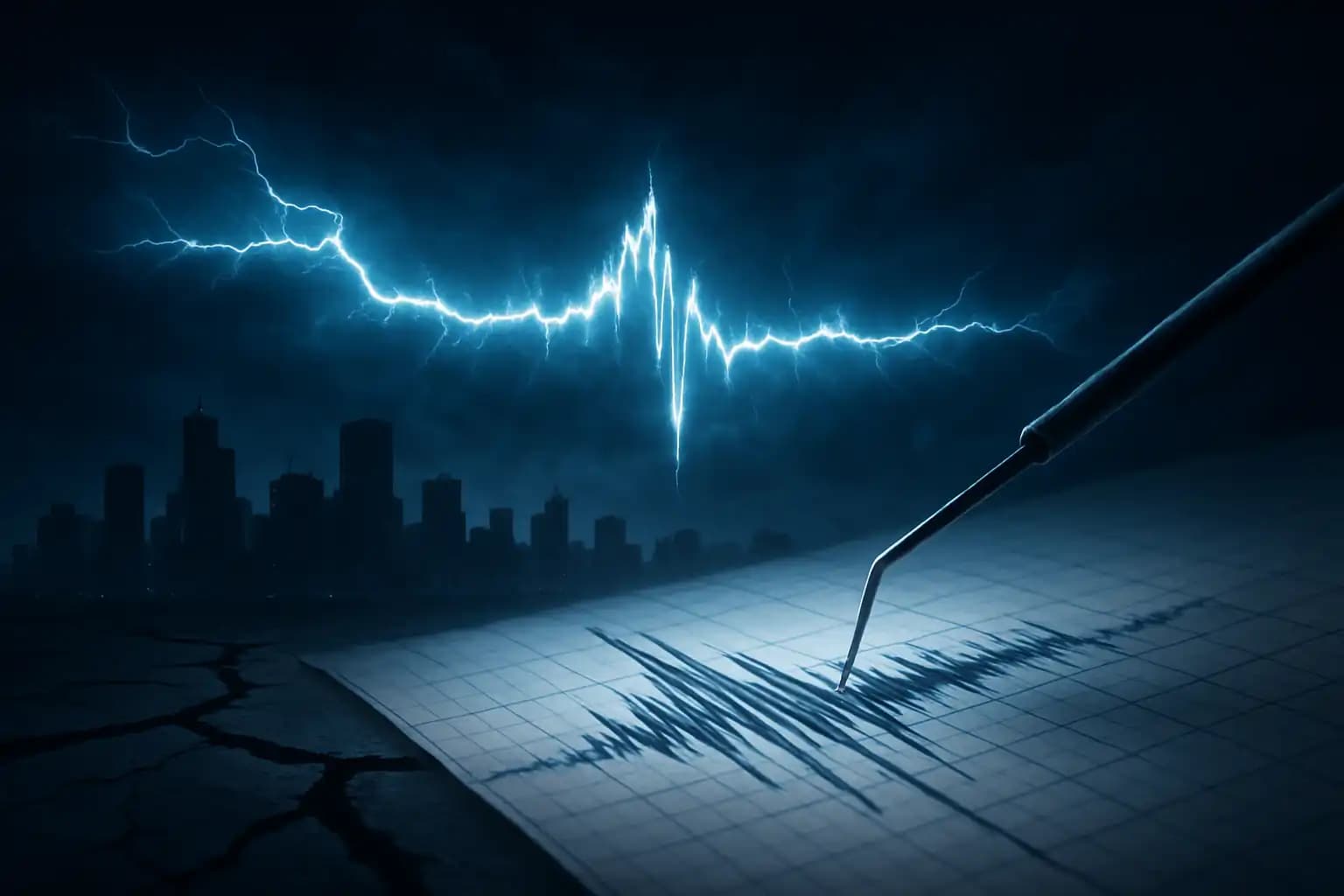1. The Day the Spectrum Screamed
At 7:19 a.m. UTC, the Tomsk Space Observing System showcased a startling chart: the calm green-and-blue bands of Earth’s Schumann resonance map turned blood-red, signaling a spike in the signal’s quality factor. Hours later, a station in Cumiana, Italy, echoed this spike. Geophysicists felt that double-hit as the planet yelling through a megaphone.
The Schumann resonances are standing electromagnetic waves trapped between Earth’s surface and the ionosphere, oscillating primarily at 7.83 Hz. Discovered in 1952 and described on Wikipedia, they act like a global bell. Solar storms, lightning bursts, and nuclear tests can jostle the amplitudes, but the quality factor—the tone’s crispness—rarely multiplies overnight. When it does, significant events usually follow.
2. Correlation or Causation? A Troubling Timeline
Geophysicist Stefan Burns examined a decade of archives and noted resonance spikes alongside event markers. Three days before the 2011 Tōhoku megathrust, the Q-factor doubled. Five days ahead of the 2018 Sulawesi quake, it climbed 40%. Similar patterns preceded the 2023 Türkiye-Syria disaster. Critics cite coincidence, yet engineers rely on Schumann baselines to calibrate ultra-low-frequency antennas, knowing anomalies rarely occur without an energetic trigger.
Satellite magnetometers reinforce this circumstantial case. Archives linked through independent magnetometer portals reveal micro-pulsations that coincide with rising ground strain. When rock micro-fractures, it releases charged aerosols, subtly affecting the atmosphere’s conductivity. That influence nudges the ionospheric mirror, amplifying the planet’s radio rumble.
3. Tectonic Powder Kegs Currently Primed
Which fault might rupture next? Burns identifies four danger zones:
- Cascadia Subduction Zone: GPS stations off Oregon show unusual landward creep this month.
- Japan’s Nankai Trough: Offshore pressure sensors logged slow-slip events, precursors to historic quakes.
- Pamir Knot, Central Asia: Deep tremor trains spiked 30% above baseline.
- Mexico’s Guerrero Gap: A 170-mile stretch remains unbroken since 1911.
Any of these could turn a resonant whisper into continental sirens.
4. The Wild Cards: Solar Weather and Geo-Plasma Holes
Space weather forecasters observed a coronal hole facing Earth, expected to unleash high-speed solar wind within 48 hours. Such streams compress the magnetosphere, sometimes exposing the South Atlantic magnetic anomaly to additional radiation. This energy can disrupt Schumann modes by perturbing the ionosphere’s lower boundary. If the resonance spike coincides with a solar barrage, the lithosphere faces double stress—external EM loading and internal release.
Another concern involves man-made electromagnetic dumping. Military very-low-frequency transmitters operate near Schumann harmonics, and HAARP-style ionospheric heaters inject megawatts into the atmosphere. Officially, these arrays never run powerful operations without notice. However, citizen watchdogs highlight spectral fingerprints appearing in open data—quirks noted in signal plots archived at ocean-monitoring logs.
5. What Amplification Looks Like on the Ground
Before rock snaps, radon gas vents through fissures, animals become restless, and radio hobbyists hear phantom whistles across shortwave bands. Italian seismologist Bianca Corzio operates VLF receivers from her farmhouse. Yesterday, she reported hiss over 8 kHz, fading by dawn. This timing aligns with Tomsk’s spike, hinting at global coherence.
Along California’s Mendocino Triple Junction, strainmeters recorded a one-in-fifty-year compression pulse. Combining this with Schumann data yields a probability curve few emergency managers can ignore. Civil-defense units, already rehearsing siren routines archived at urban-risk repositories, quietly switched radio nets to 24-hour standby.
6. Predictive Models: Promise and Peril
Can we predict earthquakes from electromagnetic foreshocks? Academic opinions divide. The “mechanism skeptics” highlight false positives: many Schumann blips occur without quakes. Supporters argue that resolution improves with dense sensor grids and refined machine-learning filters. A 2022 neural-network study, found through AI seismology digests, achieved 78% accuracy in classifying quake-linked anomalies retroactively.
Authorities hesitate to evacuate cities based on statistics. Yet failing to warn invites backlash. Japan’s Meteorological Agency faced criticism for missing the 2016 Kumamoto mainshock after ignoring VLF hints. California’s ShakeAlert team now incorporates ionospheric GPS scintillation data as a supplemental stream, though they rarely publicize it.
7. Personal Preparedness When the Planet’s Pulse Races
You cannot prevent tectonics, but you can increase your odds:
- Anchor heavy furniture. Most injuries arise from flying bookcases.
- Stock 72-hour supplies. Include water, non-perishable food, and LED lights.
- Keep offline maps. Cell towers fail under surge traffic.
- Know your shut-offs. Gas leaks can turn tremors into firestorms.
- Keep a battery radio. If power grids falter—discussed at infrastructure watchlists—you’ll still receive civil-defense updates.
8. Planetary Symphonics and Eschaton Lore
Mystics view Schumann spikes as signs of Earth “ascending.” Scientists consider them pressure gauges. Regardless, the resonance connects every living creature beneath an ionized gas roof. A mega-quake does more than topple skyscrapers; it disrupts supply chains, shifts Earth’s axis by milliarcseconds, and nudges dreamers toward end-time narratives, similar to pole-shift speculations chronicled in geocentric studies.
If the BIG ONE strikes a megacity like Tokyo, Istanbul, or Los Angeles, economic contagion will ripple across oceans within hours. Insurance markets wobble, commodity ports seize, and social media floods with AI-generated doom loops, fueling real-time panic. Geophysicists term this the secondary quake—the societal shockwave that follows the geological one.
9. The Next 96 Hours: What to Watch
Burns’ team establishes yellow, orange, and red windows based on statistical lag times between anomalies and quakes:
| Window | Risk Level | Key Indicators |
|---|---|---|
| 0–24 h | Yellow | Watch for regional swarm increases. |
| 24–72 h | Orange | Monitor ionospheric TEC maps—sudden drops may signal lithosphere-atmosphere coupling. |
| 72–96 h | Red | Groundwater radon spikes or animal mass migrations heighten probability. |
If nothing ruptures by day four, the model resets, but tension rarely dissipates; it stores like charge in a thunderhead.
10. Conclusion: Between the Beat and the Break
Earth hums constantly, yet this week it howls. Whether the resonance surge predicts a megathrust or simply records an ionospheric prank, ignoring the signal invites danger. The past century proves preparedness saves more lives than prediction. Track sensors, test your go-bag, and monitor reputable clearinghouses like Unexplained.co. If the ground remains still, celebrate a drill. If it lurches, you’ll thank the planet’s nervous system for the whispered warning.




